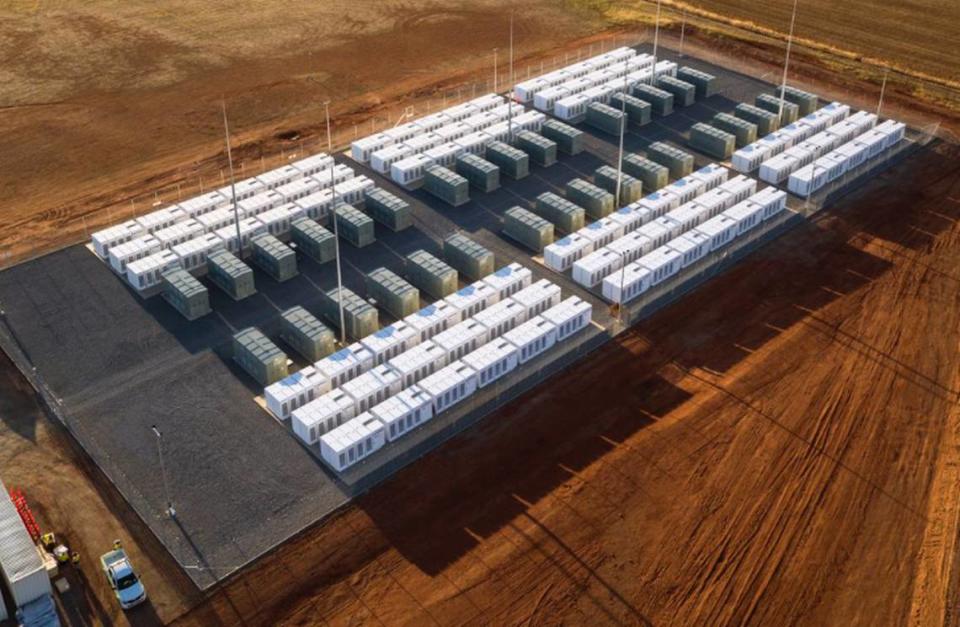Morro Bay group plans initiative to block proposed battery storage plant
A group of Morro Bay residents who call themselves Citizens for Estero Bay Preservation has submitted a citizens initiative that aims to block construction of a battery storage facility near the old power plant.
If passed, they say, the measure will require the city to follow General Plan guidelines — adopted on May 25, 2021, by the City Council and approved by the California Coastal Commission on Aug. 12, 2021 — that call for maintaining the zoning on certain parcels labeled “visitor serving commercial” and “commercial recreational fishing” along the Embarcadero.
That includes the site of the proposed Vistra Energy lithium battery plant to the north of the stacks on land last used to hold oil storage tanks.
The 24-acre site for the proposed battery plant is adjacent to a major PG&E substation, where it would connect to the California grid via high-voltage power lines that climb the hills from Morro Bay across SLO County to the California transmission system.
Battery plants are designed to balance power supply and help keep the lights on in statewide emergencies like heat waves or wildfires.
The citizens group says it is not against clean power but is focusing on the proposed location of the battery modules located near the shore of Morro Bay north of the busy Embarcadero.
The group says the plan amounts to an industrial use on a site that instead should be reserved for future visitor services.
The property has a long history of industrial use, first by the U.S. Navy, then Duke Energy and PG&E, who all had a hand in building and operating the fossil-fueled power plant with its three 360-foot-tall smoke stacks.
This industrial landscape — side by side with fishing boats — has been part of Morro Bay’s image for decades and is as recognizable as Morro Rock itself.
This 1940s technology, however, had clear downsides. It polluted the air, harmed the estuary, warmed the water, and killed sea life, for starters. Today, the bay is cleaner and its habitat, including eel grass, is on the rebound to help feed the aquatic food chain.
The transformation here is part of a worldwide move toward clean energy like solar and wind and, yes, battery storage, none of which heat the Earth or add greenhouse gases that in turn raise temperatures, boosting extreme weather events and acidifying the oceans.
Some critics, however, don’t want to see these systems in their backyard. They point to the need to preserve Morro Bay’s fishing village atmosphere.
Morro Bay’s Community Development Director Scot Graham reminds everyone that the deal with Vistra is that the company take down the 1950s power plant on their nickel, clearing all of the 107-acre site and making it ready for future uses. The battery plant calls for three 30-foot-tall buildings on 24 of those acres, leaving three-quarters of the cleared land to the community’s imagination.
“It seems premature to rule out what we want to do while our impact study is underway, including the safety aspects some are worried about,” Graham said.
Reports of fires at battery plants like nearby Moss Landing last year have raised safety questions. But the industry points to its widespread rollout and says it is safe.
The draft impact study conducted by Rincon Consultants is expected this fall, after which community forums will be held to discuss the report, Graham said.

As to community sentiment on what should replace the old power plant, Graham said one recent forum made it clear residents had plenty of ideas beside hotel or tourist services. Now, a formal community survey is expected to be released in a few months.
In a discussion on the Vistra plan last year, the Tribune reported that “During the heatwave in September, up to 7 percent of the energy on the California grid came from batteries and they are performing superbly and safely,” according to Vistra community affairs director Brad Watson, who says the infrastructure is already in Morro Bay to quickly build up storage for solar and wind power.
There is another aspect to all this.
Many of the same critics don’t want the offshore wind project either and lump their concerns together.
They fear plans could lead to some huge port facility in Morro Bay even though the bay will not accommodate anything larger than about a 120-foot boat. Heavyweight Long Beach is way ahead on securing the big wind port title.
So what’s next?
The citizens group says that by May 16, Morro Bay’s city attorney will assign a title and ballot summary for the citizens initiative. They are hoping to begin the signature campaign by the end of May or beginning of June.
Graham said the group will need to collect over 800 signatures to get the measure on the ballot by March or November of next year.
The group says it has over 200 members from Morro Bay and surrounding areas who are “against the building of a battery storage plant down by the Rock.” Administrators of their Facebook page are Judy Lynn Poudrier Setting and Betsy Gaudette-Cross.
Among their goals, they say they want to:
Protect the natural beauty, sensitivity and intrinsic value of Morro Bay’s waterfront and Embarcadero;
Prevent the visual and physical degradation of Morro Bay’s natural environment;
Promote the health and safety of Morro Bay’s residents, tourists, boaters and wildlife habitat;
Maintain present levels of coastal access to our California Historic Landmark, Morro Rock, as well as to the Harbor, and surrounding beaches; and
Preserve Morro Bay as a world-renowned tourist destination.
John Lindt is the editor of the Sierra2theSea.net news site.

